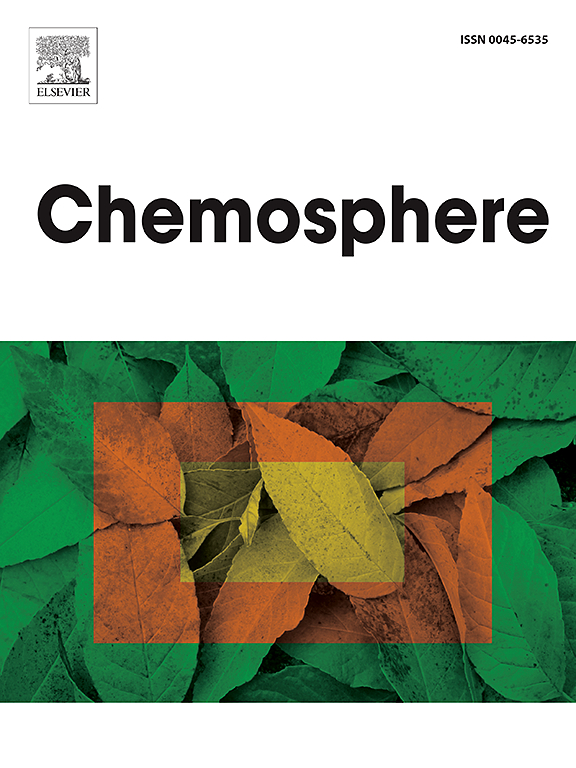Systematic design of hydrophobic deep eutectic solvents by VEGA, COSMO-RS, and experiments for efficient removal of Saxitoxin and brevetoxin from water
IF 8.1
2区 环境科学与生态学
Q1 ENVIRONMENTAL SCIENCES
引用次数: 0
Abstract
Harmful algal blooms (HABs) and their associated neurotoxins, Brevetoxin (PbTx3) and Saxitoxin (STX), pose significant environmental, economic, and public health challenges. This study investigated the design of hydrophobic deep eutectic solvents (HDES) as a green and sustainable alternative for the simultaneous removal of PbTx3 and STX from contaminated water. An initial systematic screening of 8556 potential HDES combinations was conducted using Virtual models for property Evaluation of chemicals within a Global Architecture (VEGA) evaluations and quantum chemical modeling via the Conductor-like Screening Model for Real Solvents (COSMO-RS). Key properties such as activity coefficients, intermolecular interactions, and solid-liquid equilibria were analyzed to identify optimal HDES formulations. Menthol-based HDES combined with citric, lactic, or hexanoic acids demonstrated superior performance due to their balanced hydrogen bonding and van der Waals interaction capabilities. Experimental validation confirmed the computational predictions, with these solvents achieving over 94 % removal efficiency for both toxins in individual solutions. However, competitive adsorption in mixed toxin solutions resulted in a significant reduction in STX removal efficiency. The study underscores the role of HDES in addressing dual-toxin challenges and highlights their potential as environmentally friendly alternatives to conventional toxic solvents. By leveraging green chemistry principles, this research contributes to advancing sustainable solutions for water purification and the mitigation of harmful algal blooms.

VEGA、cosmoo - rs系统设计疏水深共晶溶剂,并进行高效去除水中蛤蚌毒素和brevetoxin的实验
有害藻华(HABs)及其相关的神经毒素Brevetoxin (PbTx3)和Saxitoxin (STX)对环境、经济和公共卫生构成了重大挑战。本研究研究了疏水深共晶溶剂(HDES)的设计,作为同时去除污染水中PbTx3和STX的绿色可持续替代方案。利用全球体系结构(VEGA)评估中的化学品属性评估虚拟模型和真实溶剂类导体筛选模型(cosmos - rs)的量子化学建模,对8556种潜在的HDES组合进行了初步系统筛选。分析了活度系数、分子间相互作用和固液平衡等关键性质,以确定最佳的HDES配方。薄荷醇基HDES与柠檬酸、乳酸或己酸结合表现出优异的性能,因为它们具有平衡的氢键和范德华相互作用能力。实验验证证实了计算预测,这些溶剂在单个溶液中对两种毒素的去除效率超过94%。然而,在混合毒素溶液中的竞争吸附导致STX去除效率显著降低。该研究强调了HDES在解决双重毒素挑战方面的作用,并强调了它们作为传统有毒溶剂的环保替代品的潜力。通过利用绿色化学原理,本研究有助于推进水净化和减少有害藻华的可持续解决方案。
本文章由计算机程序翻译,如有差异,请以英文原文为准。
求助全文
约1分钟内获得全文
求助全文
来源期刊

Chemosphere
环境科学-环境科学
CiteScore
15.80
自引率
8.00%
发文量
4975
审稿时长
3.4 months
期刊介绍:
Chemosphere, being an international multidisciplinary journal, is dedicated to publishing original communications and review articles on chemicals in the environment. The scope covers a wide range of topics, including the identification, quantification, behavior, fate, toxicology, treatment, and remediation of chemicals in the bio-, hydro-, litho-, and atmosphere, ensuring the broad dissemination of research in this field.
 求助内容:
求助内容: 应助结果提醒方式:
应助结果提醒方式:


